There are over 190 vascular plant species on the Norwegian Arctic archipelago of Svalbard. This figure does not include algae, mosses, and lichens, which are non-vascular plants. For an island so far north, this number of species constitutes an astonishing variety of plant life. Because of the harsh climate and the short growing season, all the plants are slow growing. They seldom grow higher than 10 cm (4 in)
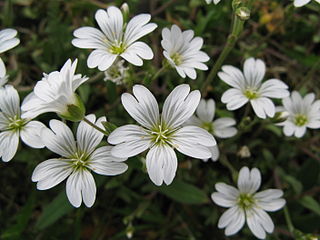
Cerastium is a genus of annual, winter annual, or perennial plants belonging to the family Caryophyllaceae. They are commonly called mouse-ear chickweed. Species are found nearly worldwide but the greatest concentration is in the northern temperate regions. There are about 200 species. A number are common weeds in fields and on disturbed ground.
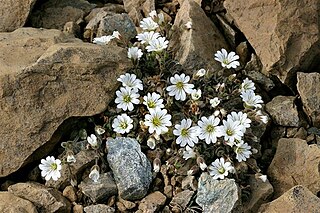
Cerastium nigrescens, commonly known as the Shetland mouse-ear, Shetland mouse-eared chickweed or Edmondston's chickweed, is an endemic flowering plant found in Shetland, Scotland.

Cerastium biebersteinii, the boreal chickweed, is an ornamental plant in the genus Cerastium and the family Caryophyllaceae. It is an endemic of the Crimea. The species is named after a German botanist Friedrich August Marschall von Bieberstein.

Cerastium glomeratum is a species of flowering plant in the family Caryophyllaceae known by the common names sticky mouse-ear chickweed and clammy chickweed. It is probably native to Eurasia but it is known on most continents as an introduced species. It grows in many types of habitat. The blooming period is February, March, April, and May.

Cerastium arvense is a species of flowering plant in the pink family known by the common names field mouse-ear and field chickweed. It is a widespread species, occurring throughout Europe and North America, as well as parts of South America. It is a variable species. There are several subspecies, but the number and defining characteristics are disputed.
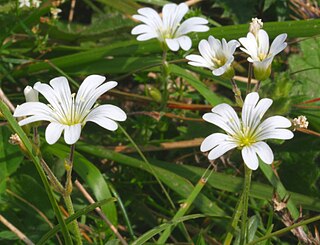
Cerastium alpinum, commonly called alpine mouse-ear or alpine chickweed, is a mat-forming perennial plant. The species was first described by Carl Linnaeus in 1753. It is native to Greenland, Canada and northern Europe. It is grown as a rock garden subject for its many small white flowers and silver haired stems and foliage. There are three subspecies.

Cerastium brachypetalum, commonly called gray chickweed, grey mouse-ear or gray mouse-ear chickweed, is a spring blooming annual plant species. It is native from Eurasia and introduced and naturalized in North America.

Cerastium fontanum, also called mouse-ear chickweed, common mouse-ear, or starweed, is a species of mat-forming perennial or, rarely, annual plant. It is native to Europe but introduced elsewhere. Its identifying characteristics are tear-shaped leaves growing opposite one another in a star pattern, hairy leaves, and small white flowers. Mouse-ear chickweed typically grows to 4"-8" tall and spreads horizontally along the ground via the formation of roots wherever the stem falls over and contacts the ground.

Tripterygium regelii, or Regel's threewingnut, is a rambling, shrubby perennial deciduous yellow vine native to Korea, Japan and Manchuria. It grows to about 200 centimetres (79 in). Small very pretty yellowish white or white flowers appear in May–June and are produced on 203–229 millimetres (8.0–9.0 in). long panicles, and smell somewhat of new-mown hay. Fruits are greenish white, 3-angled, and winged.
"Tripterygium wilfordii Hook.f., known as Leigongteng in traditional Chinese medicine, has attracted much attention for its applications in relieving autoimmune disorders such as rheumatoid arthritis and systemic lupus erythematosus, and for treating cancer. Molecular analyses of the ITS and 5S rDNA sequences indicate that T. hypoglaucum and T. doianum are not distinct from T. wilfordii, while T. regelii should be recognized as a separate species. The results also demonstrate potential value of rDNA sequence data in forensic detection of adulterants derived from Celastrus angulatus in commercial samples of Leigongteng."
Coleophora lithargyrinella is a moth of the family Coleophoridae found in Europe.
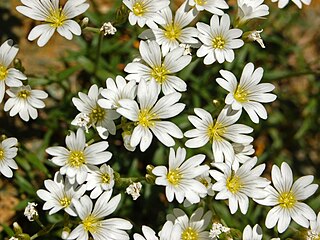
Cerastium utriense is a species of perennial flowering plant in the genus Cerastium, belonging to the family Caryophyllaceae. It was first described in 1988. It is endemic to Italy.

Cerastium cerastoides, the mountain chickweed or starwort mouse-ear, is a flowering plant species in the pink family Caryophyllaceae found in the mountains of Europe.
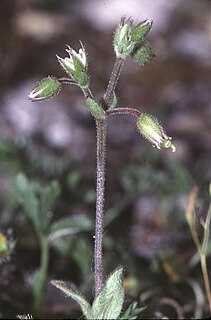
Cerastium pumilum, the dwarf mouse-ear or European chickweed, is an annual or biannual herbaceous plant, between 2 and 20 cm. high, native to Central and western Europe. The petals of the white flowers are shorter or equally long as the sepals, and split in the middle, up to a quarter of the length. The fruit petioles stand diagonal to the stems, often bent over at their top. Flowering occurs between March and May. Rarely occurs on the seacoast.

Cerastium diffusum, the fourstamen chickweed or sea mouse-ear, is a species of flowering plant in the pink and carnation family Caryophyllaceae. It is an annual herb, to 30 cm.high, occurring in western Europe and northern Africa. Found mainly in coastal areas of Algeria, the Baleares, Belgium, Corsica, Denmark, France, the Faroe Islands, Germany, Great Britain, Ireland, Italy, Libya, Morocco, Netherlands, Norway, Portugal, Sardinia, Sicily, Spain and Sweden. The flowers have 4, petals, 4 or 5 stamens appearing between March and May. The petals are much shorter than the sepals. The leaves are opposite, (sessile) without petioles and the sepals and bracts are all green, without pale margins. The fruit petioles are erect and diffuse at maturity.
Iljinia is a monotypic genus of flowering plants belonging to the family Amaranthaceae. It only contains one species, Iljinia regelii(Bunge) Korovin ex Iljin

Cerastium subtriflorum, the Slovenian mouse-ear chickweed, is a perennial plant species in the family Caryophyllaceae. It is mostly restricted to the Slovenian and Italian Alps.
Cerastium ligusticum is a species of annual herb in the family Caryophyllaceae. They have a self-supporting growth form. They have simple, broad leaves. Individuals can grow to 0.11 m.
Pyrus regelii is a species of wild pear in the family Rosaceae, native to Central Asia. A small tree usually 6 m (20 ft) tall, but reaching 9 m (30 ft), its young branches are cloaked in a grey down, which provides visual interest when it is planted as an ornamental. Its leaves, which are also downy when young, are exceptionally variable in shape, sometimes even on the same individual. The fruit are small but typical pears, and are collected and eaten by local peoples. The most xerophytic member of its genus, it is occasionally used as a rootstock for cultivated pear trees, as a garden ornamental, and for reforestation projects, all in dry areas.














